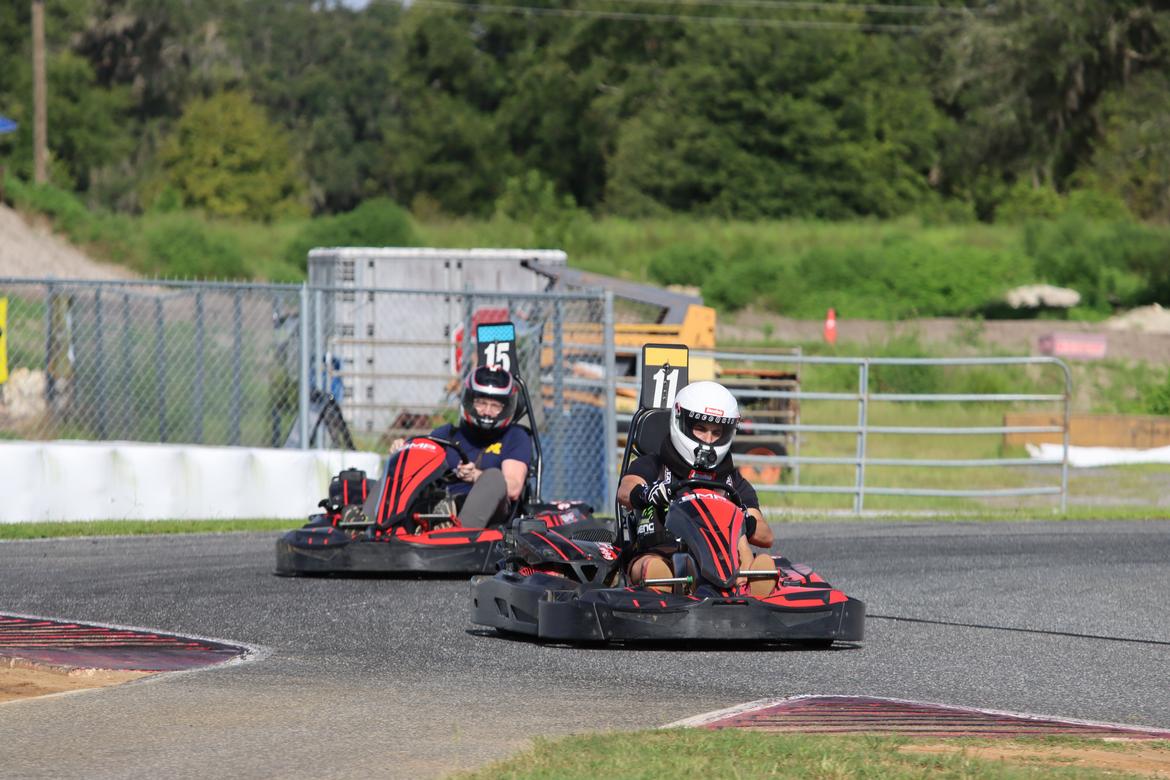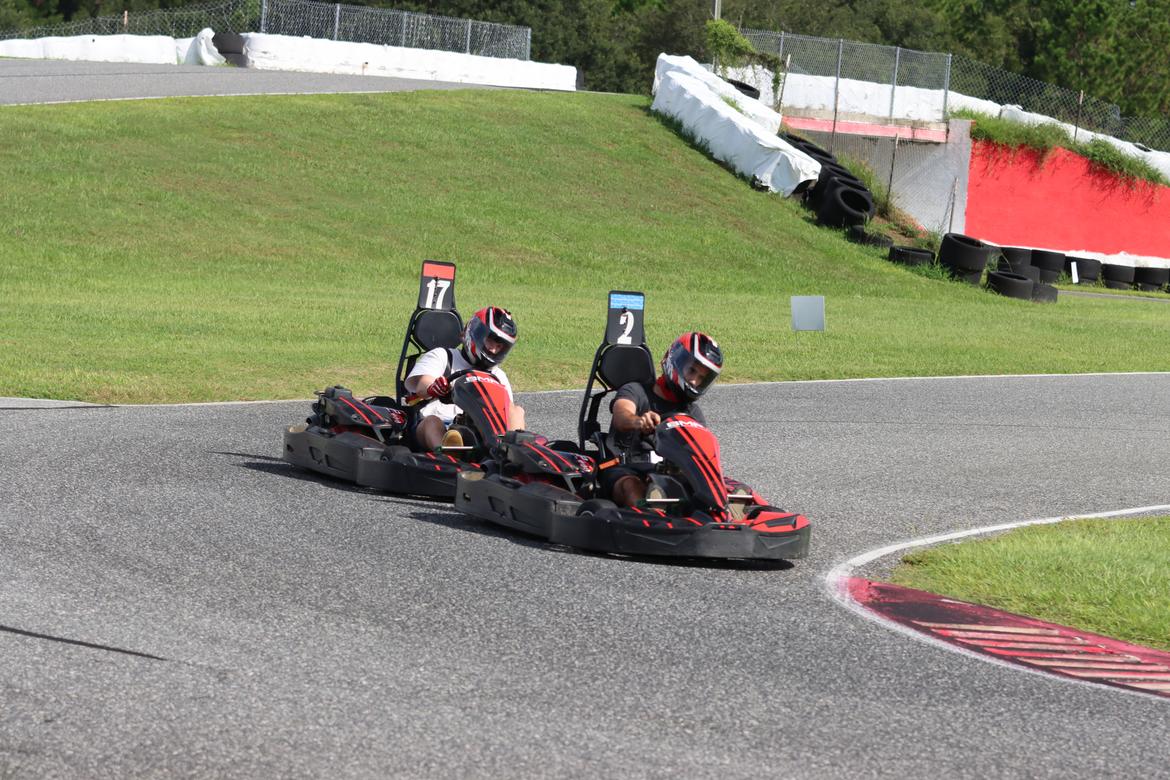How racing karts reinforced driving fundamentals for just $100

I had no plans for this past Saturday. Apparently, my social media feed knew about this as well: Friday I was served an ad for a nearby drop-in rental kart league that had spots available for a race taking place the very next morning.
A hundred bucks later, I was registered for my first kart experience in nearly three decades.
I know a lot of you will file this under “Tell me something I DON’T know,” but for me, karting hasn’t really been on my radar for a while. And after this experience I’m kind of (well, really) regretting that. It served as a great way to reset a few things skill-wise and focus on basic elements of driving.
I rolled up to Bushnell Motorsports Park in Bushnell, Florida, not knowing entirely what to expect, but a BMW M4 wearing BMW CCA stickers and a 911 in the parking lot told me I was among friends.
My hundo got me two 8-minute practice sessions and two 10-lap races in the track’s Sodi rental karts. They’re not the fastest karts out there, but they’re certainly fast enough to put the proper laws of physics on display.
Best of all, there was an equalization factor, meaning that drivers were either in a lightweight (180-pound driver) or heavyweight (240-pound driver) class. Drivers would need to carry ballast to match one of those numbers. Track-provided weights were available as you loaded into the karts, and the whole experience was very arrive-and-drive with zero stress.
The on-track action, though, was stressful in the best possible way, hence why you’re reading about it here, because I had kind of forgotten what a good exercise karting is for our full-size automotive track endeavors.
The elemental nature of karts really puts the physics of contact patch management into high definition. Although these heavily armored rental karts probably weigh well north of 300 pounds, you as the driver are still a substantial part of the mass of the system, and you’re sitting right at the center of rotation, so your perception of what each tire is doing is really clear.
The low-powered nature of rental karts also emphasizes the importance of “quiet hands” on the wheel. You simply don’t have the thrust to overcome the friction the tires can produce, so every control input needs to be highly deliberate and suitably gentle. You need to move your hands quick enough to get the desired result and develop cornering force, but not so quick that you lose additional forward momentum.
Likewise, on-track battles tend to develop in slow motion. I drove four karts in my four sessions, and while the crew at Bushnell Motorsports Park did a fantastic job preparing them, each still had its strengths and weaknesses.
All were probably capable of producing a lap time within the margin of error of each other, but they’d do it in slightly different ways. Some understeered a bit more, so you’d have to judiciously use the brakes (which are rear-wheel only, don’t forget) on turn-in to get the front to bite while allowing the rear to rotate toward the apex.
Some had clutches that engaged a bit more gently, so you had to drive them like am old-school turbo car, getting to the power early so you had full acceleration–such as it was–as you started unwinding the wheel toward daylight.
So when it came to the battles among drivers, you had to maximize your strengths and drive around your weaknesses, which is really a fun part of the game. Mostly, though, battles came down to waiting for an opponent to make a mistake and following close enough to take advantage of that mistake without being so close that their mistake also killed your momentum.
As it in in any form of motorsport, momentum is critical here. If you lost momentum, you were getting passed, and because of the geography of the track and the low-powered nature of the karts, you were probably going to get passed by multiple drivers in a freight train that was now keeping you out of position.
Again, there are all very valuable skills to hone, and karting provided the opportunity to work on them in an affordable, low-risk, high-fun environment.
No, I’m not rushing out to buy my own kart–I’ve done the two-stroke race car thing already and that was enough for me–but I’m absolutely going to show up for some more arrive-and-drive races.
Aside from Bushnell Motorsports Park, which runs these sprint races plus solo enduros as well as team enduros ranging from 90 minutes to 12 hours, we have a couple other kart facilities within a couple of hours of our Florida east coast base.
And, chances are, you have a kart facility within a reasonable drive as well. I highly recommend taking advantage of it as it’s exceptional cross-training and really makes you focus on fundamentals as there’s simply no covering for bad technique in a kart.
I started my day about 3 seconds off the leader in my group. By the final session, I was within half a second of the fastest car in my race and finished my second race just 4 seconds off the leader. A lot of it was learning curve, but most of it was focusing on solid technique of friction circle management and doing as little work as necessary to change direction.
And these are all techniques I know, but they’re also techniques that are easy to compensate for with modern 300-plus hp cars and sticky, forgiving 200tw tires. Karting really delivers those messages to all your senses very clearly, and it should be part of your own driving development program. That it’s also inexpensively fun AF is simply a nice bonus.
If you ever want to do an endurance race and need a slower partner, I'm in!
A million years ago, JG, Rennie and I confidently showed up for an eight-hour kart enduro. We got this, we figured.
After our first practice, we realized that we were so over our heads. For one, everyone wore real kart suits. And they were built like real kart racers.
By the end of the race, we drafted any willing and able body to join us.
I can still recall sitting across from a puddle of JG at a burrito shop for our post-race dinner. Soon after, pretty sure I fell asleep on the way home in JG’s CRX. (Sorry, JG.)
In reply to David S. Wallens :
That sounds like so much fun! Though I am very out of shape and don't think I could handle sharing an equal portion of the time, I would sure try!
Austin Cannon said:If you need a slower partner, I'm in!
I actually said something similar when I asked my wife to marry me.
Austin Cannon said:In reply to David S. Wallens :
That sounds like so much fun! Though I am very out of shape and don't think I could handle sharing an equal portion of the time, I would sure try!
You’re in. Our roster eventually included a friend’s dad, the truck driver who delivered the rental karts and the owner of the track.
In reply to Austin Cannon :
We should start going karting again, it has been way too long since we have.
I am also down for an endurance race.
David S. Wallens said:A million years ago, JG, Rennie and I confidently showed up for an eight-hour kart enduro. We got this, we figured.
After our first practice, we realized that we were so over our heads. For one, everyone wore real kart suits. And they were built like real kart racers.
By the end of the race, we drafted any willing and able body to join us.
I can still recall sitting across from a puddle of JG at a burrito shop for our post-race dinner. Soon after, pretty sure I fell asleep on the way home in JG’s CRX. (Sorry, JG.)
Yeah that was fun for the first 15 minutes or so...
The sprint races are a blast, though. The BMP race I did was two eight minute practices then two ten lap races of about 13 minutes each. It was long enough to start feeling it, but honestly I'm more gassed after a night at my pickleball league. It's definitely within the realm of doable for mortals.
Fitting into the karts helps, too. I remember the Endurance Karting setups having a very long reach to the pedals for me. the BMP karts had adjustable pedals and I was able to get a more proper bent leg seating position and that helped immensely. It would still be awesome to have karts with FiA seats, though.
BMP does a one-hour solo enduro series that I wouldn't mind trying at some point. Call it a long-term goal. It requires two pit stops and I think my yardstick will be "which put stop do I use to just get out of the kart and head for my car while I can still stand upright?"
And, yeah, we definitely need to do a company enduro sometime. They also do them at the Orlando track. Would be good practice for the Miata (except the kart would probably run the whole time).
You'll need to log in to post.
grassrootsmotorsports







